Peruvian Solar Observatory, Thai Forest Join Unesco Heritage List

News Synopsis
Latest Update- 31/12/2022
Among the most recent additions to the UNESCO list of the world's most culturally significant locations are a 2,300-year-old solar observatory in Peru a national park in Thailand close to the Myanmar border, and an ancient Chinese commerce town with a famous mosque.
The large Kaeng Krachan forest complex in Thailand and the old city of Quanzhou in China were added to the list of World Heritage Sites on Sunday. On Tuesday the Chankillo observatory in Peru which was created before the advent of the Inca empire was recognized as being such.
Then in 2007 research published in the journal Science suggested Chankillo was in part a solar observatory and towers built between 200 and 300 BC marked the summer and winter solstices. The towers were created with amazing care according to Peruvian archaeologist Ivan Ghezzi who co-authored that paper with British colleague Clive Ruggles to mark different sun positions and ultimately mark exact dates. Their objective was to accurately time the month's solstices and equinoxes as well as the planting and harvesting seasons well as religious celebrations. The building displays the passage of time over the course of a year like a big clock. Chankillo is the height of Peruvian history. A technical scientific and architectural marvel. During a visit to the location, Ghezzi told AFP that it is the birthplace of astronomy in America.
Last Updated- 31/7/2021
Archaeologists may have uncovered what they say is by far the oldest astronomical observatory in the Americas. A series of towers near a temple in coastal Peru, built in the fourth century B.C. Chankillo is unique among ancient observatory sites because of its two observation points, similar sites around the world contain only one point of astronomical alignment, which does not provide the measurements needed to track the passage of time over a full year.
The towers at Chankillo mark the sun's progress across the sky, according to a new study of Science. This suggests the sun may have played an important role in religious and political life long before the appearance of the famous Inca sun cult. which gradually shifts along the horizon for a year. The archaeological evidence at Chankillo suggests that sun worship existed in the Andes around two millennia before the well-known sun cult of the Inca Empire. The Chankillo Astronomical Complex was inscribed on the UNESCO World Heritage List. The decision by UNESCO affirms the priceless nature of Chankillo as a resource for helping understand the worldview of ancient societies and their advancements in tracking the cyclical passage of celestial bodies, ensuring this exceptional heritage continues to benefit all of humanity.









